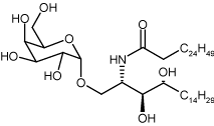Replaces Prod. #: ALX-306-027
KRN7000 is a synthetic analog of α-galactosylceramide and the marine natural product agelasphin. It is a specific ligand for human and mouse NKT cells and remains the best studied ligand of the lipid-binding MHC class I-like protein CD1d. It protects against LPS-induced shock and displays potent antitumor activity in various in vivo models.
Product Details
| Alternative Name: | α-Galactosylceramide, α-Gal-Cer, (2S,3S,4R)-1-O-(α-D-Galactosyl)-N-hexacosanoyl-2-amino-1,3,4-octadecanetriol |
| |
| Formula: | C50H99NO9 |
| |
| MW: | 858.3 |
| |
| Source: | Synthetic. |
| |
| CAS: | 158021-47-7 |
| |
| Purity: | ≥98% (TLC) |
| |
| Appearance: | White solid. |
| |
| Solubility: | KRN7000 is inherently an extremely hydrophobic molecule, therefore, almost all the methods for solubilizing this material in primarily aqueous media will contain at least some detergent. For cell culture or other in vivo models, it is recommended that the KRN7000 be initially dissolved in a 2:1 mixture of chloroform and methanol. This solution should then be aliquoted into amounts suitable for a day’s use into glass vials. After aliquoting, the chloroform/methanol solvent can be evaporated off under a stream of nitrogen or argon. We recommend turning the tube during this process to try to get the KRN7000 deposited in as thin a film as possible. The thinner the KRN7000 layer is, the easier it will be to reconstitute it. These dry aliquots can then be stored under nitrogen or argon at -20°C for several months or until needed.
On the day of the experiment, use a dried aliquot and reconstitute it using any of the options listed below:
-
PBS with 0.5% Tween-20. Note: It will be necessary to warm at 37°C and sonicate for 2 hours or more in a water bath sonicator in order to get the material to dissolve. Heating and sonication should be done immediately prior to every use.
-
5.6% sucrose with 0.75% L-histidine and 0.5% Tween-20. Heating to 80°C for several minutes will be necessary with this solvent system.
-
100% DMSO (anhydrous). It is critical that the DMSO be completely anhydrous. Heating to 80°C may be necessary to get the KRN7000 to completely dissolve. Please note: while this method will produce a true clear solution in DMSO, the KRN7000 will be very likely to precipitate out as soon as the DMSO is diluted into aqueous media. It is recommended that the aqueous media the DMSO stock solution will be diluted in should contain 10% serum, or BSA and that the DMSO stock solution be diluted no more than 1/100. Depending upon the make-up of the aqueous buffer, there may well still be a precipitate, however the precipitate should eventually disappear with warming and repeated vortexing or sonication in a water bath sonicator. This may take some time and will likely need to be repeated each time an aliquot is thawed for use.
Depending upon the solvent system used and the final concentration of the KRN7000, the results may be either a true clear solution or a somewhat cloudy suspension. The cloudy suspensions are not a problem, and will work fine when treating cells, just make sure they are mixed well immediately before use. |
| |
| Shipping: | Blue Ice |
| |
| Long Term Storage: | -20°C |
| |
| Use/Stability: | Store solutions at -20°C for up to 3 months. |
| |
| Regulatory Status: | RUO - Research Use Only |
| |
Please mouse over
Product Literature References
Repeated α-GalCer Administration Induces a Type 2 Cytokine-Biased iNKT Cell Response and Exacerbates Atopic Skin Inflammation in Vα14Tg NC/Nga Mice: H.J. Park, et al.; Biomedicines
9, 1619 (2021),
Abstract;
α-galactosylceramide-reactive NKT cells increase IgG1 class switch against a C. difficile polysaccharide antigen and enhance immunity against a live pathogen: G.A. Lang, et al.; Infect. Immun.
89, e0043821 (2021),
Abstract;
Acute invariant NKT cell activation triggers an immune response that drives prominent changes in iron homeostasis: H. Huang, et al.; Sci. Rep.
10, 21026 (2020),
Abstract;
Full Text
A Potent CD1d-binding Glycolipid for iNKT-Cell-based Therapy Against Human Breast Cancer: T. Seki, et al.; Anticancer Res.
39, 549 (2019),
Application(s): used w/ MDA-MB231 cells ,
Abstract;
Full Text
Novel immunostimulators with a thiazolidin-4-one ring promote the immunostimulatory effect of human iNKT cells on the stimulation of Th2-like immune responsiveness via GATA3 activation in vitro: M. Meng, et al.; Int. Immunopharmacol.
39, 353 (2016),
Application(s): Cell culture, iNKTs production,
Abstract;
Involvement of a C-terminal motif in the interference of primate lentiviral Vpu proteins with CD1d-mediated antigen presentation: S. M. Bächle, et al.; Sci. Rep.
5, 9675 (2015),
Application(s): Cell Culture, Assay,
Abstract;
Full Text
Inhibition of lipid antigen presentation in dendritic cells by HIV-1 Vpu interference with CD1d recycling from endosomal compartments: M. Moll, et al.; Blood
116, 1876 (2010),
Abstract;
Invariant valpha14 natural killer T cell activation by edible mushroom acidic glycosphingolipids: H. Nozaki, et al.; Biol. Pharm. Bull.
33, 580 (2010),
Abstract;
Temporal differences in the dependency on phosphoinositide-dependent kinase 1 distinguish the development of invariant Valpha14 NKT cells and conventional T cells: D.K. Finlay, et al.; J. Immunol.
185, 5973 (2010),
Abstract;
Full Text
Pivotal advance: alpha-galactosylceramide induces protection against lipopolysaccharide-induced shock: G. Sireci, et al.; J. Leukoc. Biol.
81, 607 (2007),
Abstract;
Production and characterization of monoclonal antibodies against complexes of the NKT cell ligand alpha-galactosylceramide bound to mouse CD1d: K.O. Yu, et al.; J. Immunol. Methods
323, 11 (2007),
Abstract;
A phase I study of alpha-galactosylceramide (KRN7000)-pulsed dendritic cells in patients with advanced and recurrent non-small cell lung cancer: A. Ishikawa, et al.; Clin. Cancer Res.
11, 1910 (2005),
Abstract;
Modulation of CD1d-restricted NKT cell responses by using N-acyl variants of alpha-galactosylceramides: K.O. Yu, et al.; PNAS
102, 3383 (2005),
Abstract;












